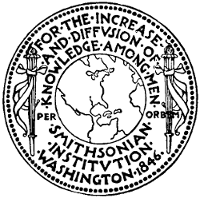
This eBook is for the use of anyone anywhere at no cost and with almost no restrictions whatsoever. You may copy it, give it away or re-use it under the terms of the Project Gutenberg License included with this eBook or online at www.gutenberg.org
Title: The First Man-Carrying Aeroplane Capable of Sustained Free Flight: Langley's Success as a Pioneer in Aviation
From the Smithsonian Report for 1914, pages 217-222, Publication 2329, 1915
Author: Albert Francis Zahm
Release Date: December 19, 2013 [eBook #44466]
Language: English
Character set encoding: ISO-8859-1
***START OF THE PROJECT GUTENBERG EBOOK THE FIRST MAN-CARRYING AEROPLANE CAPABLE OF SUSTAINED FREE FLIGHT: LANGLEY'S SUCCESS AS A PIONEER IN AVIATION***
| Note: | Images of the original pages are available through Internet Archive/American Libraries. See https://archive.org/details/firstmancarrying00zahm |
BY
A. F. ZAHM, Ph. D.
FROM THE SMITHSONIAN REPORT FOR 1914, PAGES 217-222
(WITH 8 PLATES)

(Publication 2329)
WASHINGTON
GOVERNMENT PRINTING OFFICE
1915
THE FIRST MAN-CARRYING AEROPLANE CAPABLE OF
SUSTAINED FREE FLIGHT—LANGLEY’S SUCCESS AS A
PIONEER IN AVIATION.
By A. F. Zahm, Ph. D.
[With 8 plates.]
It is doubtful whether any person of the present generation will be able to appraise correctly the contributions thus far made to the development of the practical flying machine. The aeroplane as it stands to-day is the creation not of any one man, but rather of three generations of men. It was the invention of the nineteenth century; it will be the fruition, if not the perfection, of the twentieth century. During the long decades succeeding the time of Sir George Cayley, builder of aerial gliders and sagacious exponent of the laws of flight, continuous progress has been made in every department of theoretical and practical aviation—progress in accumulating the data of aeromechanics, in discovering the principles of this science, in improving the instruments of aerotechnic research, in devising the organs and perfecting the structural details of the present-day dynamic flying machine. From time to time numerous aerial craftsmen have flourished in the world’s eye, only to pass presently into comparative obscurity, while others too neglected or too poorly appreciated in their own day subsequently have risen to high estimation and permanent honor in the minds of men.
Something of this latter fortune was fated to the late Secretary of the Smithsonian Institution. For a decade and a half Dr. Langley had toiled unremittingly to build up the basic science of mechanical flight, and finally to apply it to practical use. He had made numerous model aeroplanes propelled by various agencies—by India rubber, by steam, by gasoline—all operative and inherently stable. Then with great confidence he had constructed for the War Department a man flier which was the duplicate, on a fourfold scale, of his successful gasoline model. But on that luckless day in December, 1903, when he expected to inaugurate the era of substantial aviation, an untoward accident to his launching gear badly crippled his carefully and adequately designed machine. The aeroplane was repaired, but not again tested until the spring of 1914—seven years after Langley’s death.
Such an accident, occurring now, would be regarded as a passing mishap; but at that time it seemed to most people to demonstrate the futility of all aviation experiments. The press overwhelmed the inventor with ridicule; the great scientist himself referred to the accident as having frustrated the best work of his life. Although he felt confident of the final success of his experiments, further financial support was not granted and he was forced to suspend operations. Scarcely could he anticipate that a decade later, in a far away little hamlet, workmen who had never known him would with keenest enthusiasm rehabilitate that same tandem monoplane, and launch it again and again in successful flight, and that afterwards in the National Capital it should be assigned the place of honor among the pioneer vehicles of the air.
When in March, 1914, Mr. Glenn H. Curtiss was invited to send a flying boat to Washington to participate in celebrating “Langley Day,”[1] he replied, “I would like to put the Langley aeroplane itself in the air.” Learning of this remark Secretary Walcott, of the Smithsonian Institution, soon authorized Mr. Curtiss to recanvas the original Langley aeroplane and launch it either under its own propulsive power or with a more recent engine and propeller. Early in April, therefore, the machine was taken from the Langley Laboratory and shipped in a box car to the Curtiss Aviation Field, beside Lake Keuka, Hammondsport, N. Y. In the following month it was ready for its first trial since the unfortunate accident of 1903.
[1] May 6, the anniversary of the famous flight of Langley’s steam model aeroplane in 1896, is known in Washington as “Langley Day,” and has been celebrated with aerial maneuvers over land and water.
The main objects of these renewed trials were, first, to show whether the original Langley machine was capable of sustained free flight with a pilot, and, secondly, to determine more fully the advantages of the tandem type of aeroplane. The work seemed a proper part of the general program of experiments planned for the recently reopened Langley Aerodynamical Laboratory. It was, indeed, for just such experimentation that the aeroplane had been given to the Smithsonian Institution by the War Department, at whose expense it had been developed and brought to completion prior to 1903. After some successful flights at Hammondsport the famous craft could, at the discretion of the Smithsonian Institution, either be preserved for exhibition or used for further scientific study. To achieve the two main objects above mentioned, the aeroplane would first be flown as nearly as possible in its original condition, then with such modifications as might seem desirable for technical or other reasons.
Various ways of launching were considered. In 1903 the Langley aeroplane was launched from the top of a houseboat. A car supporting it and drawn by lengthy spiral springs ran swiftly along a track, then suddenly dropped away, leaving the craft afloat in midair with its propellers whirring and its pilot supplementing, with manual control, if need be, the automatic stability of the machine. This method of launching, as shown by subsequent experimentalists, is a practical one and was favorably entertained by Mr. Curtiss. He also thought of starting from the ground with wheels, from the ice with skates, from the water with floats. Having at hand neither a first rate smooth field nor a sheet of ice, he chose to start from the water.
Smithsonian Report, 1914.—Zahm.
Plate 1.
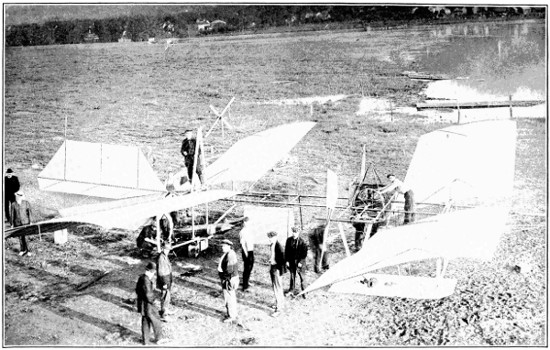
Langley Aeroplane (Built 1898-1903) Ready for Launching at Hammondsport, N. Y., May 28, 1914.
Smithsonian Report, 1914.—Zahm.
Plate 2.
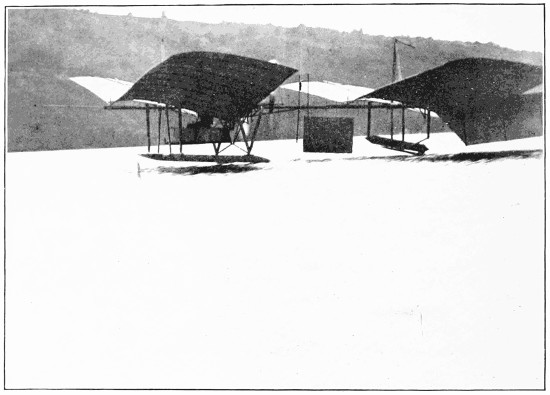
Langley Aeroplane Just Rising from Water, June 2, 1914, Piloted by Curtiss.
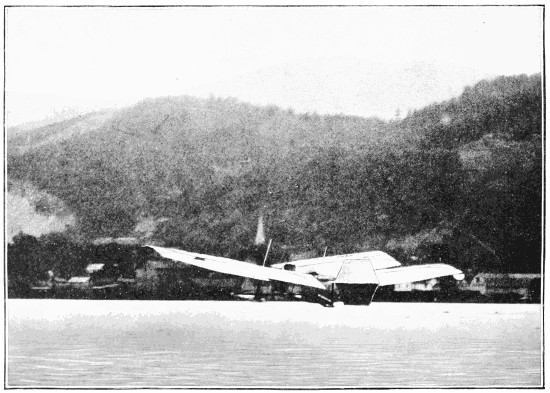
Flight of Langley Aeroplane with its Own Power Plant Over Lake Keuka, June 2, 1914, Piloted by Curtiss.
Smithsonian Report, 1914.—Zahm.
Plate 3.
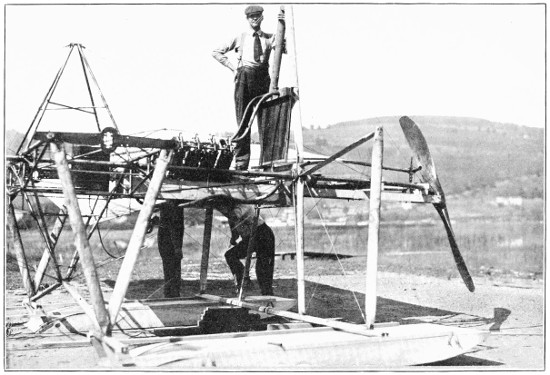
Curtiss 80-Horsepower Motor and Tractor Screw Mounted on Langley Aeroplane.
Smithsonian Report, 1914.—Zahm.
Plate 4.
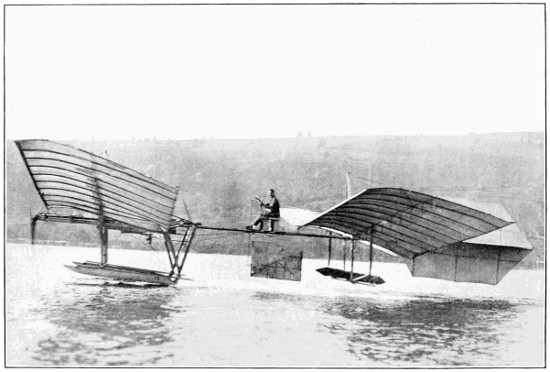
Elwood Doherty Clearing the Water September 17, 1914, in the Langley Aeroplane Driven by a Curtiss 80-Horsepower Motor and Tractor Screw.
In the accompanying illustrations, plates 1 and 2 show the appearance of the Langley flying machine after Mr. Curtiss had provided it with hydroaeroplane floats and their connecting truss work. The steel main frame, the wings, the rudders, the engine and propellers all were substantially as they had been in 1903. The pilot had the same seat under the main frame, and the same general system of control as in 1903. He could raise or lower the craft by moving the big rear rudder up and down; he could steer right and left by turning the vertical rudder. He had no ailerons nor wing-warping mechanism, but for lateral balance depended upon the dihedral angle of the wings and upon suitable movements of his weight or of the vertical rudder. And here it may be noted that Langley had placed the vertical steering rudder under and to the rear of the center of gravity. So placed, it served as a fairly good aileron by exerting a turning movement about the longitudinal axis of the machine.
After the adjustments for actual flight had been made in the Curtiss factory, according to the minute descriptions contained in the Langley Memoir on Mechanical Flight, the aeroplane was taken to the shore of Lake Keuka, beside the Curtiss hangars, and assembled for launching. On a clear morning (May 28), and in a mild breeze, the craft was lifted onto the water by a dozen men and set going, with Mr. Curtiss at the steering wheel, ensconced in the little boat-shaped car under the forward part of the frame. Many eager witnesses and camera men were at hand, on shore and in boats. The four-winged craft, pointed somewhat across the wind, went skimming over the wavelets, then automatically headed into the wind, rose in level poise, soared gracefully for 150 feet, and landed softly on the water near the shore. Mr. Curtiss asserted that he could have flown farther, but, being unused to the machine, imagined the left wings had more resistance than the right. The truth is that the aeroplane was perfectly balanced in wing resistance, but turned on the water like a weather vane owing to the lateral pressure on its big rear rudder. Hence in future experiments this rudder was made turnable about a vertical axis, as well as about the horizontal axis used by Langley. Henceforth the little vertical rudder under the frame was kept fixed and inactive.
After a few more flights with the Langley aeroplane, kept as nearly as possible in its original condition, its engine and twin propellers were replaced by a Curtiss 80-horse motor and direct-connected tractor propeller mounted on the steel frame, well forward, as shown in the photographs. It was hoped in this way to spare the original engine and propeller bearings, which were none too strong for the unusual burden added by the floats. In 1903 the total weight of pilot and machine had been 830 pounds; with the floats lately added it was 1,170 pounds; with the Curtiss motor and all ready for flight it was 1,520 pounds. But notwithstanding these surplus additions of 40 per cent and 85 per cent above the original weight of the craft, the delicate wing spars and ribs were not broken, nor was any part of the machine excessively overstrained.
Owing to the pressure of other work at the factory, the aeroplane equipped with the Curtiss motor was not ready for further flights till September. In the absence of Mr. Curtiss, who had gone to California in August, a pupil of his aviation school, Mr. Elwood Doherty, volunteered to act as pilot.
During some trials for adjusting the aeroplane controls and the center of gravity, Mr. Doherty, on the afternoon of September 17, planed easily over the water, rose on level wing, and flew about 450 feet, at an elevation of 2 or 3 yards, as shown by the accompanying photographs of that date. Presently two other like flights were made. Mr. Doherty found that with the forewings at 10° incidence, the rear ones at 12°, and the pilot’s seat on the main frame about midway between the wings, the flier responded nicely to the movements of the pilot wheel. A slight turn of the wheel steered the craft easily to right or left, a slight pull or push raised or lowered it. The big double tail, or rudder, which responded to these movements, was the only steering or control surface used. The breaking of the 8-foot tractor screw terminated these trials for the day. The waves indicate the strength of the wind during the flights.
On September 19, using a 9-foot screw, Mr. Doherty began to make longer flights. A pleasant off-shore breeze rippled the water, but without raising whitecaps. A dozen workmen, lifting the great tandem monoplane from the shore, with the pilot in his seat, waded into the lake and set it gently on the water. A crowd of witnesses near at hand, and many scattered about the shores, and on the lofty vine-clad hills, stood watching expectantly. When some of the official observers and photographers, in a motor boat, were well out in the lake, a man in high-top boots, standing in the water, started the propeller, and stepped quickly out of the way. Then with its great yellow wings beautifully arched and distended, the imposing craft ran swiftly out from the shore, gleaming brilliantly in the afternoon sun. At first the floats and lower edges of the rudders broke the water to a white surge, then as the speed increased they rose more and more from the surface. Presently the rear floats and the rudders cleared the water, the front floats still skipping on their heels, white with foam. The whole craft was now in soaring poise. It quickly approached the photographers, bearing on its back the alert pilot, who seemed to be scrutinizing every part of it and well satisfied to let it race. Then it rose majestically and sailed on even wing 1,000 feet; sank softly, skimmed the water, and soared another 1,000 feet; grazed the water again, rose and sailed 3,000 feet; turned on the water and came back in the same manner; and, as it passed the photographers, soared again nearly half a mile. The flights were repeated a few minutes later, then, owing to squally weather, were discontinued for 11 days.
Smithsonian Report, 1914.—Zahm.
Plate 5.
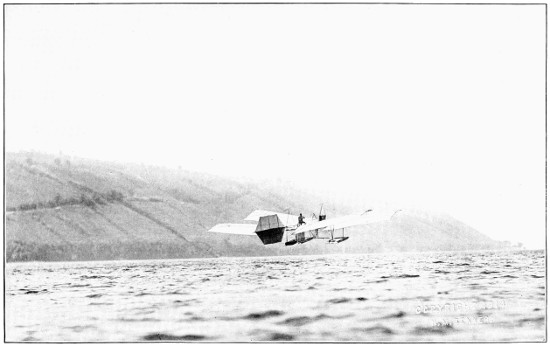
Flight of Langley Aeroplane above Lake Keuka September 17, 1914, Piloted by E. Doherty and Driven by a Curtiss Motor and Tractor Screw.
Smithsonian Report, 1914.—Zahm.
Plate 7.
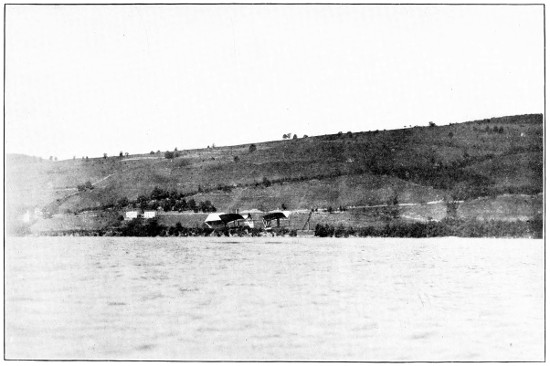
Langley Aeroplane in Flight October 1, 1914; Natural Poise.
Smithsonian Report, 1914.—Zahm.
Plate 8.
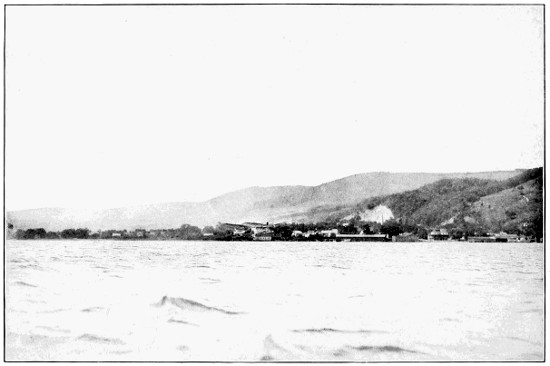
Langley Aeroplane in Flight October 1, 1914. Hammondsport, N. Y., in Background.
On October 1, 1914, the aeroplane was launched at 11 a. m. in an off-shore breeze strong enough to raise whitecaps. Hovering within 30 feet of the water, and without material loss of speed, it made in quick succession flights of the following duration, as observed by four of us in a motor boat and timed by myself: 20 seconds, 20 seconds, 65 seconds, 20 seconds, 40 seconds, 45 seconds. As the speed through air averaged about 50 feet per second, the through air lengths of these flights were, respectively, 1,000 feet, 1,000 feet, 3,250 feet, 1,000 feet, 2,000 feet, 2,250 feet. As the aeroplane was now well out from shore among the heavy billows and white caps, Mr. Doherty landed it upon the water and turned it half about for the homeward flight. Thereupon the propeller tips struck the waves and were broken off, one casting a splinter through the center of the left wing. The pilot stopped the engine, rested in his seat, and was towed home by our motor boat. The flights were witnessed and have been attested by many competent observers.
As to the performance of the aeroplane during these trials, the pilot, Mr. E. Doherty, reports, and we observed, that the inherent lateral stability was excellent, the fore-and-aft control was satisfactory, and the movement of the craft both on the water and in the air was steady and suitable for practical flying in such weather. Apparently the machine could have flown much higher, and thus avoided touching the water during the lulls in the breeze; but higher flying did not seem advisable with the frail trussing of wings designed to carry 830 pounds instead of the 1,520 pounds actual weight.
At the present writing the Langley aeroplane is in perfect condition and ready for any further tests that may be deemed useful. But it has already fulfilled the purpose for which it was designed. It has demonstrated that, with its original structure and power, it is capable of flying with a pilot and several hundred pounds of useful load. It is the first aeroplane in the history of the world of which this can be truthfully said.
If the experiments be continued under more painstaking technical direction, longer flights can easily be accomplished. Mr. Manly, who designed the Langley engine and screws and who directed the construction and tests of the large aeroplane up to December 8, 1903, reports that he obtained from the propulsion plant a static thrust of 450 pounds, and that he once ran the engine under full load for 10 hours consecutively. This thrust is nearly 100 pounds more than that commonly obtained at Hammondsport with the same plant, and 20 pounds more than the static thrust obtained with the Curtiss motor on the day when it flew the aeroplane with 1,520 pounds aggregate weight. Hence, by restoring the engine and propellers to their original normal working condition they should be able to drive the aeroplane in successful flight with an aggregate weight of nearly 1,600 pounds, even when hampered with the floats and their sustaining truss work. With a thrust of 450 pounds, the Langley aeroplane, without floats, restored to its original condition and provided with stronger bearings, should be able to carry a man and sufficient supplies for a voyage lasting practically the whole day.
Dr. Langley’s aerotechnic work may be briefly summarized as follows:
1. His aerodynamic experiments, some published and some as yet unpublished, were complete enough to form a basis for practical pioneer aviation.
2. He built and launched, in 1896, the first steam model aeroplane capable of prolonged free flight, and possessing good inherent stability.
3. He built the first internal-combustion motor suitable for a practical man-carrying aeroplane.
4. He developed and successfully launched the first gasoline model aeroplane capable of sustained free flight.
5. He developed and built the first man-carrying aeroplane capable of sustained free flight.

This e-text follows the text of the original publication.
Some minor punctuation
inconsistencies have been regularised.
***END OF THE PROJECT GUTENBERG EBOOK THE FIRST MAN-CARRYING AEROPLANE CAPABLE OF SUSTAINED FREE FLIGHT: LANGLEY'S SUCCESS AS A PIONEER IN AVIATION***
******* This file should be named 44466-h.txt or 44466-h.zip *******
This and all associated files of various formats will be found in:
http://www.gutenberg.org/4/4/4/6/44466
Updated editions will replace the previous one--the old editions will be renamed.
Creating the works from public domain print editions means that no one owns a United States copyright in these works, so the Foundation (and you!) can copy and distribute it in the United States without permission and without paying copyright royalties. Special rules, set forth in the General Terms of Use part of this license, apply to copying and distributing Project Gutenberg-tm electronic works to protect the PROJECT GUTENBERG-tm concept and trademark. Project Gutenberg is a registered trademark, and may not be used if you charge for the eBooks, unless you receive specific permission. If you do not charge anything for copies of this eBook, complying with the rules is very easy. You may use this eBook for nearly any purpose such as creation of derivative works, reports, performances and research. They may be modified and printed and given away--you may do practically ANYTHING with public domain eBooks. Redistribution is subject to the trademark license, especially commercial redistribution.
To protect the Project Gutenberg-tm mission of promoting the free distribution of electronic works, by using or distributing this work (or any other work associated in any way with the phrase "Project Gutenberg"), you agree to comply with all the terms of the Full Project Gutenberg-tm License available with this file or online at www.gutenberg.org/license.
1.A. By reading or using any part of this Project Gutenberg-tm electronic work, you indicate that you have read, understand, agree to and accept all the terms of this license and intellectual property (trademark/copyright) agreement. If you do not agree to abide by all the terms of this agreement, you must cease using and return or destroy all copies of Project Gutenberg-tm electronic works in your possession. If you paid a fee for obtaining a copy of or access to a Project Gutenberg-tm electronic work and you do not agree to be bound by the terms of this agreement, you may obtain a refund from the person or entity to whom you paid the fee as set forth in paragraph 1.E.8.
1.B. "Project Gutenberg" is a registered trademark. It may only be used on or associated in any way with an electronic work by people who agree to be bound by the terms of this agreement. There are a few things that you can do with most Project Gutenberg-tm electronic works even without complying with the full terms of this agreement. See paragraph 1.C below. There are a lot of things you can do with Project Gutenberg-tm electronic works if you follow the terms of this agreement and help preserve free future access to Project Gutenberg-tm electronic works. See paragraph 1.E below.
1.C. The Project Gutenberg Literary Archive Foundation ("the Foundation" or PGLAF), owns a compilation copyright in the collection of Project Gutenberg-tm electronic works. Nearly all the individual works in the collection are in the public domain in the United States. If an individual work is in the public domain in the United States and you are located in the United States, we do not claim a right to prevent you from copying, distributing, performing, displaying or creating derivative works based on the work as long as all references to Project Gutenberg are removed. Of course, we hope that you will support the Project Gutenberg-tm mission of promoting free access to electronic works by freely sharing Project Gutenberg-tm works in compliance with the terms of this agreement for keeping the Project Gutenberg-tm name associated with the work. You can easily comply with the terms of this agreement by keeping this work in the same format with its attached full Project Gutenberg-tm License when you share it without charge with others.
1.D. The copyright laws of the place where you are located also govern what you can do with this work. Copyright laws in most countries are in a constant state of change. If you are outside the United States, check the laws of your country in addition to the terms of this agreement before downloading, copying, displaying, performing, distributing or creating derivative works based on this work or any other Project Gutenberg-tm work. The Foundation makes no representations concerning the copyright status of any work in any country outside the United States.
1.E. Unless you have removed all references to Project Gutenberg:
1.E.1. The following sentence, with active links to, or other immediate access to, the full Project Gutenberg-tm License must appear prominently whenever any copy of a Project Gutenberg-tm work (any work on which the phrase "Project Gutenberg" appears, or with which the phrase "Project Gutenberg" is associated) is accessed, displayed, performed, viewed, copied or distributed:
This eBook is for the use of anyone anywhere at no cost and with almost no restrictions whatsoever. You may copy it, give it away or re-use it under the terms of the Project Gutenberg License included with this eBook or online at www.gutenberg.org
1.E.2. If an individual Project Gutenberg-tm electronic work is derived from the public domain (does not contain a notice indicating that it is posted with permission of the copyright holder), the work can be copied and distributed to anyone in the United States without paying any fees or charges. If you are redistributing or providing access to a work with the phrase "Project Gutenberg" associated with or appearing on the work, you must comply either with the requirements of paragraphs 1.E.1 through 1.E.7 or obtain permission for the use of the work and the Project Gutenberg-tm trademark as set forth in paragraphs 1.E.8 or 1.E.9.
1.E.3. If an individual Project Gutenberg-tm electronic work is posted with the permission of the copyright holder, your use and distribution must comply with both paragraphs 1.E.1 through 1.E.7 and any additional terms imposed by the copyright holder. Additional terms will be linked to the Project Gutenberg-tm License for all works posted with the permission of the copyright holder found at the beginning of this work.
1.E.4. Do not unlink or detach or remove the full Project Gutenberg-tm License terms from this work, or any files containing a part of this work or any other work associated with Project Gutenberg-tm.
1.E.5. Do not copy, display, perform, distribute or redistribute this electronic work, or any part of this electronic work, without prominently displaying the sentence set forth in paragraph 1.E.1 with active links or immediate access to the full terms of the Project Gutenberg-tm License.
1.E.6. You may convert to and distribute this work in any binary, compressed, marked up, nonproprietary or proprietary form, including any word processing or hypertext form. However, if you provide access to or distribute copies of a Project Gutenberg-tm work in a format other than "Plain Vanilla ASCII" or other format used in the official version posted on the official Project Gutenberg-tm web site (www.gutenberg.org), you must, at no additional cost, fee or expense to the user, provide a copy, a means of exporting a copy, or a means of obtaining a copy upon request, of the work in its original "Plain Vanilla ASCII" or other form. Any alternate format must include the full Project Gutenberg-tm License as specified in paragraph 1.E.1.
1.E.7. Do not charge a fee for access to, viewing, displaying, performing, copying or distributing any Project Gutenberg-tm works unless you comply with paragraph 1.E.8 or 1.E.9.
1.E.8. You may charge a reasonable fee for copies of or providing access to or distributing Project Gutenberg-tm electronic works provided that
1.E.9. If you wish to charge a fee or distribute a Project Gutenberg-tm electronic work or group of works on different terms than are set forth in this agreement, you must obtain permission in writing from both the Project Gutenberg Literary Archive Foundation and Michael Hart, the owner of the Project Gutenberg-tm trademark. Contact the Foundation as set forth in Section 3 below.
1.F.
1.F.1. Project Gutenberg volunteers and employees expend considerable effort to identify, do copyright research on, transcribe and proofread public domain works in creating the Project Gutenberg-tm collection. Despite these efforts, Project Gutenberg-tm electronic works, and the medium on which they may be stored, may contain "Defects," such as, but not limited to, incomplete, inaccurate or corrupt data, transcription errors, a copyright or other intellectual property infringement, a defective or damaged disk or other medium, a computer virus, or computer codes that damage or cannot be read by your equipment.
1.F.2. LIMITED WARRANTY, DISCLAIMER OF DAMAGES - Except for the "Right of Replacement or Refund" described in paragraph 1.F.3, the Project Gutenberg Literary Archive Foundation, the owner of the Project Gutenberg-tm trademark, and any other party distributing a Project Gutenberg-tm electronic work under this agreement, disclaim all liability to you for damages, costs and expenses, including legal fees. YOU AGREE THAT YOU HAVE NO REMEDIES FOR NEGLIGENCE, STRICT LIABILITY, BREACH OF WARRANTY OR BREACH OF CONTRACT EXCEPT THOSE PROVIDED IN PARAGRAPH 1.F.3. YOU AGREE THAT THE FOUNDATION, THE TRADEMARK OWNER, AND ANY DISTRIBUTOR UNDER THIS AGREEMENT WILL NOT BE LIABLE TO YOU FOR ACTUAL, DIRECT, INDIRECT, CONSEQUENTIAL, PUNITIVE OR INCIDENTAL DAMAGES EVEN IF YOU GIVE NOTICE OF THE POSSIBILITY OF SUCH DAMAGE.
1.F.3. LIMITED RIGHT OF REPLACEMENT OR REFUND - If you discover a defect in this electronic work within 90 days of receiving it, you can receive a refund of the money (if any) you paid for it by sending a written explanation to the person you received the work from. If you received the work on a physical medium, you must return the medium with your written explanation. The person or entity that provided you with the defective work may elect to provide a replacement copy in lieu of a refund. If you received the work electronically, the person or entity providing it to you may choose to give you a second opportunity to receive the work electronically in lieu of a refund. If the second copy is also defective, you may demand a refund in writing without further opportunities to fix the problem.
1.F.4. Except for the limited right of replacement or refund set forth in paragraph 1.F.3, this work is provided to you 'AS-IS', WITH NO OTHER WARRANTIES OF ANY KIND, EXPRESS OR IMPLIED, INCLUDING BUT NOT LIMITED TO WARRANTIES OF MERCHANTABILITY OR FITNESS FOR ANY PURPOSE.
1.F.5. Some states do not allow disclaimers of certain implied warranties or the exclusion or limitation of certain types of damages. If any disclaimer or limitation set forth in this agreement violates the law of the state applicable to this agreement, the agreement shall be interpreted to make the maximum disclaimer or limitation permitted by the applicable state law. The invalidity or unenforceability of any provision of this agreement shall not void the remaining provisions.
1.F.6. INDEMNITY - You agree to indemnify and hold the Foundation, the trademark owner, any agent or employee of the Foundation, anyone providing copies of Project Gutenberg-tm electronic works in accordance with this agreement, and any volunteers associated with the production, promotion and distribution of Project Gutenberg-tm electronic works, harmless from all liability, costs and expenses, including legal fees, that arise directly or indirectly from any of the following which you do or cause to occur: (a) distribution of this or any Project Gutenberg-tm work, (b) alteration, modification, or additions or deletions to any Project Gutenberg-tm work, and (c) any Defect you cause.
Project Gutenberg-tm is synonymous with the free distribution of electronic works in formats readable by the widest variety of computers including obsolete, old, middle-aged and new computers. It exists because of the efforts of hundreds of volunteers and donations from people in all walks of life.
Volunteers and financial support to provide volunteers with the assistance they need are critical to reaching Project Gutenberg-tm's goals and ensuring that the Project Gutenberg-tm collection will remain freely available for generations to come. In 2001, the Project Gutenberg Literary Archive Foundation was created to provide a secure and permanent future for Project Gutenberg-tm and future generations. To learn more about the Project Gutenberg Literary Archive Foundation and how your efforts and donations can help, see Sections 3 and 4 and the Foundation information page at www.gutenberg.org
The Project Gutenberg Literary Archive Foundation is a non profit 501(c)(3) educational corporation organized under the laws of the state of Mississippi and granted tax exempt status by the Internal Revenue Service. The Foundation's EIN or federal tax identification number is 64-6221541. Contributions to the Project Gutenberg Literary Archive Foundation are tax deductible to the full extent permitted by U.S. federal laws and your state's laws.
The Foundation's principal office is located at 4557 Melan Dr. S. Fairbanks, AK, 99712., but its volunteers and employees are scattered throughout numerous locations. Its business office is located at 809 North 1500 West, Salt Lake City, UT 84116, (801) 596-1887. Email contact links and up to date contact information can be found at the Foundation's web site and official page at www.gutenberg.org/contact
For additional contact information:
Dr. Gregory B. Newby
Chief Executive and Director
gbnewby@pglaf.org
Project Gutenberg-tm depends upon and cannot survive without wide spread public support and donations to carry out its mission of increasing the number of public domain and licensed works that can be freely distributed in machine readable form accessible by the widest array of equipment including outdated equipment. Many small donations ($1 to $5,000) are particularly important to maintaining tax exempt status with the IRS.
The Foundation is committed to complying with the laws regulating charities and charitable donations in all 50 states of the United States. Compliance requirements are not uniform and it takes a considerable effort, much paperwork and many fees to meet and keep up with these requirements. We do not solicit donations in locations where we have not received written confirmation of compliance. To SEND DONATIONS or determine the status of compliance for any particular state visit www.gutenberg.org/donate
While we cannot and do not solicit contributions from states where we have not met the solicitation requirements, we know of no prohibition against accepting unsolicited donations from donors in such states who approach us with offers to donate.
International donations are gratefully accepted, but we cannot make any statements concerning tax treatment of donations received from outside the United States. U.S. laws alone swamp our small staff.
Please check the Project Gutenberg Web pages for current donation methods and addresses. Donations are accepted in a number of other ways including checks, online payments and credit card donations. To donate, please visit: www.gutenberg.org/donate
Professor Michael S. Hart was the originator of the Project Gutenberg-tm concept of a library of electronic works that could be freely shared with anyone. For forty years, he produced and distributed Project Gutenberg-tm eBooks with only a loose network of volunteer support.
Project Gutenberg-tm eBooks are often created from several printed editions, all of which are confirmed as Public Domain in the U.S. unless a copyright notice is included. Thus, we do not necessarily keep eBooks in compliance with any particular paper edition.
Most people start at our Web site which has the main PG search facility: www.gutenberg.org
This Web site includes information about Project Gutenberg-tm, including how to make donations to the Project Gutenberg Literary Archive Foundation, how to help produce our new eBooks, and how to subscribe to our email newsletter to hear about new eBooks.